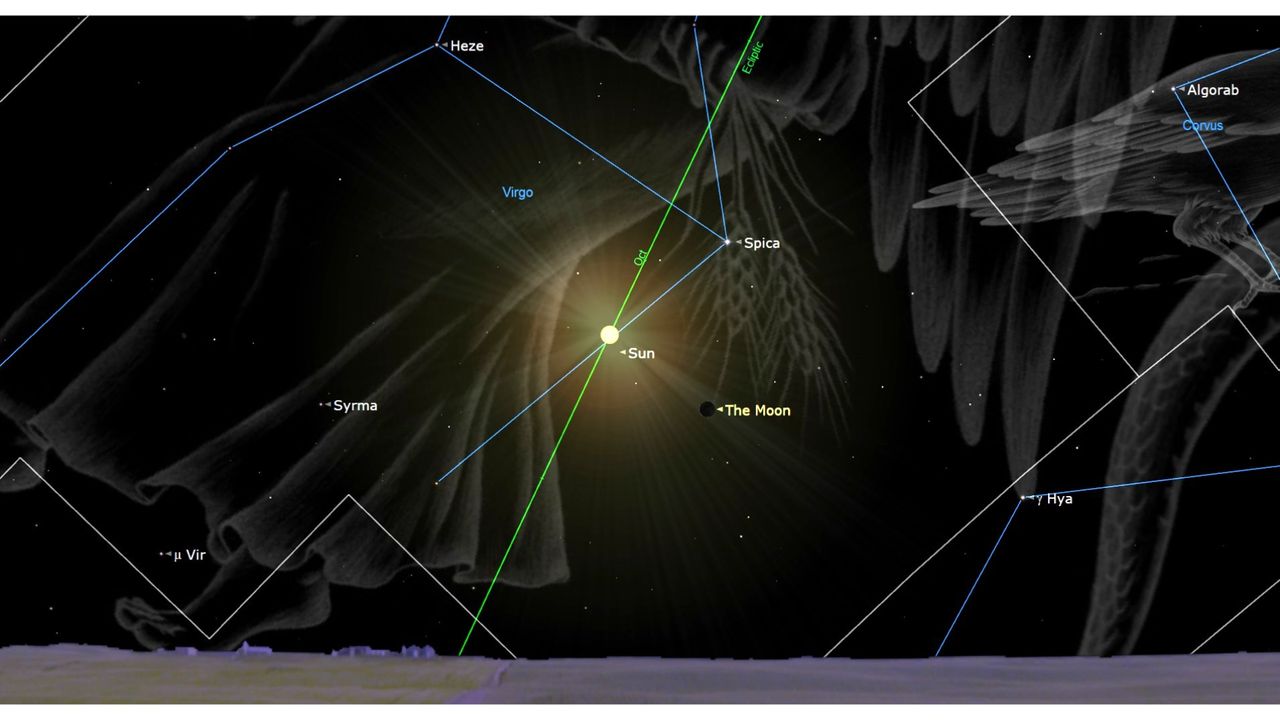Science
Stargazers Prepare for Rare Antares Occultation on October 24

The upcoming new moon on October 24, 2025, will create ideal conditions for stargazers in parts of South America and the Falklands, as it will pass in front of the red supergiant star Antares. This celestial event will coincide with the peak of the Orionid meteor shower, providing a spectacular viewing opportunity for those located within the path of the occultation.
A new moon occurs when the sun and moon align, making the moon nearly invisible against the dark sky. According to the U.S. Naval Observatory, this month’s new moon will occur on October 21, 2025, at 8:25 a.m. Eastern Daylight Time (1225 UTC). While the new moon itself will not eclipse the sun, it will obscure Antares, the brightest star in the constellation Scorpius, for observers in select regions.
Occultations, where one celestial body passes in front of another, are not particularly rare. However, the narrow shadow cast by the moon makes it challenging to observe from specific locations. The variation in the moon’s position against the background stars can differ by as much as two degrees, depending on the observer’s location.
For instance, in New York City, the moon will appear below Antares during the occultation, which will not be visible due to the horizon at that point. Conversely, Ushuaia, Argentina, will provide a clearer view. Observers there can expect the occultation to begin at 10:35 p.m. on October 24, with Antares disappearing behind the moon’s upper right quadrant.
In Punta Arenas, Chile, the occultation will start at 10:37 p.m., following a similar pattern as in Ushuaia. Antares will reappear from the left side of the moon at 11:28 p.m., with the moon approximately nine degrees above the horizon at that time.
Peak Viewing Conditions for the Orionid Meteor Shower
This new moon will also coincide with the peak of the Orionid meteor shower, which is known for its bright meteors originating from the famous Halley’s Comet. The dark skies provided by the new moon will enhance visibility for those hoping to catch a glimpse of the shooting stars.
For those unable to witness the occultation, several prominent planets will be visible in the night sky throughout late October. For observers in cities like New York, Chicago, or Sacramento, Saturn will be the first planet to appear. On October 21, Saturn rises at 5:54 p.m., becoming prominent in the southeastern sky by 7:30 p.m. The planet will reach its highest point at 10:47 p.m. before setting at 4:36 a.m. on October 22.
Following Saturn, Jupiter will rise at 11:16 p.m. EDT on October 21, reaching an altitude of 71 degrees in the constellation Gemini, just below the star Pollux. This will provide a striking contrast against the twinkling stars, making Jupiter easy to spot.
Venus, the third brightest object in the sky after the sun and moon, will rise just before dawn on October 22 at 5:37 a.m. It will be visible until shortly before sunrise at 7:15 a.m. Observers may find it an interesting challenge to see how close to sunrise they can still identify Venus.
Southern Hemisphere Stargazing Opportunities
For those in the Southern Hemisphere, particularly in cities like Santiago, Chile, conditions are favorable for viewing Mars and Mercury, which become more prominent as daylight fades. On October 21, sunset in Santiago occurs at 8:00 p.m., allowing ample time for observing both planets shortly after dusk.
As the evening progresses, the southern sky will feature the Southern Cross, with its brightest star Acrux just above the horizon. Observers can also look for Antares, which will be visible in the constellation Scorpius, positioned about 25 degrees high in the sky.
As mid-latitude observers prepare for the celestial events of October, they can look forward to not only the occultation of Antares but also the spectacle of the Orionid meteor shower and the visibility of several planets. This October promises to be an exciting month for both seasoned astronomers and casual stargazers alike.
-

 Science4 weeks ago
Science4 weeks agoALMA Discovers Companion Orbiting Giant Red Star π 1 Gruis
-

 Top Stories2 months ago
Top Stories2 months agoNew ‘Star Trek: Voyager’ Game Demo Released, Players Test Limits
-

 Politics2 months ago
Politics2 months agoSEVENTEEN’s Mingyu Faces Backlash Over Alcohol Incident at Concert
-

 World2 months ago
World2 months agoGlobal Air Forces Ranked by Annual Defense Budgets in 2025
-

 World2 months ago
World2 months agoElectrification Challenges Demand Advanced Multiphysics Modeling
-

 World2 months ago
World2 months agoMass Production of F-35 Fighter Jet Drives Down Costs
-

 Business2 months ago
Business2 months agoGold Investment Surge: Top Mutual Funds and ETF Alternatives
-

 Science2 months ago
Science2 months agoTime Crystals Revolutionize Quantum Computing Potential
-

 Top Stories2 months ago
Top Stories2 months agoDirecTV to Launch AI-Driven Ads with User Likenesses in 2026
-

 Entertainment2 months ago
Entertainment2 months agoFreeport Art Gallery Transforms Waste into Creative Masterpieces
-

 Health2 months ago
Health2 months agoGavin Newsom Critiques Trump’s Health and National Guard Plans
-

 Business2 months ago
Business2 months agoUS Government Denies Coal Lease Bid, Impacting Industry Revival Efforts









